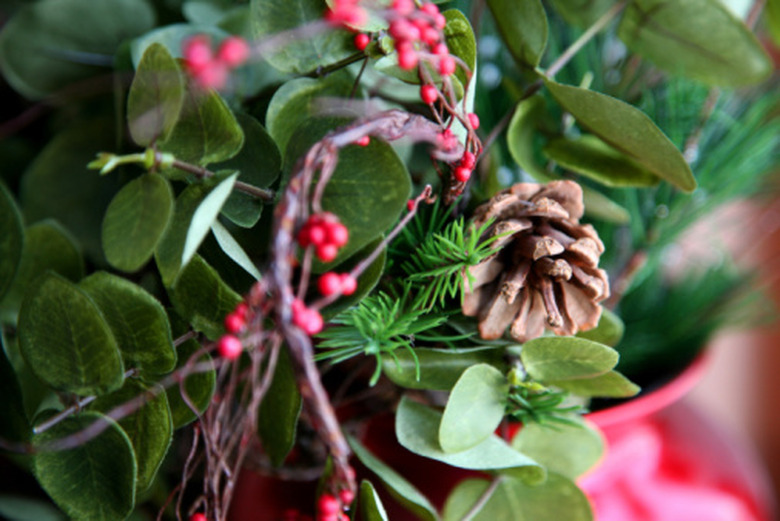Berry Plants In Floral Arrangements
Berry plant sprigs add color and varied texture to floral arrangements. Because berry plants of varying types grow year-round, you can find berries of different colors and sizes to accent your floral arrangements. Berry plants are best dried before using, unless the arrangement is fresh and will be displayed for a short duration. Along with drying, berry plants may be shellacked to preserve the vibrant colors.
Drying Berry Plants for Arrangements
The two easiest methods of drying berry plants are air drying, or the use of desiccants. Air dry the plants by grouping one or two sprigs of berries together and tying the stems with twine or rubber bands. Hang the sprigs from a hanger, hook, drying rack or cup hook–inserted into rafters or joists in a dry, warm, dark place with good ventilation–until the sprigs are completely dry (three or more weeks). Start with undamaged, dry berry sprigs picked when they look their best.
- Berry plant sprigs add color and varied texture to floral arrangements.
- Along with drying, berry plants may be shellacked to preserve the vibrant colors.
Desiccants are materials that absorb the moisture from berries, flowers, leaves or other vegetation. Efficient desiccants for drying berry plants include equal parts sand and borax; equal parts white cornmeal and borax; or silica gel granules. Lay berry sprigs on top of a desiccant layer in an airtight container. The desiccant may be sprinkled over the berry plant sprigs if desired.
Fall and Winter Berry Plants
There are many beautiful berry plants that bear fruit in the fall and winter. Many of these berry plants are regional and may be available through florists. The Ilex verticillata, "Winterberry Holly," bears vibrant red berries in the fall and throughout the spring. The berries darken somewhat when dried, but remain colorful. These berries are popular in holiday floral arrangements. The Callicarpa bodinieri, "Beautyberry," features bright magenta to purple berries–versatile colors good for floral arrangements year-round. Both the Winterberry Holly and the Beautyberry are reproduced as artificial berry sprigs for use in floral arrangements.
- Desiccants are materials that absorb the moisture from berries, flowers, leaves or other vegetation.
- The Callicarpa bodinieri, "Beautyberry," features bright magenta to purple berries–versatile colors good for floral arrangements year-round.
Spring and Summer Berry Plants
Berry plants that come to fruition in the spring and summer months are as widely varied in color as fall and winter berry plants. The Hypericum perforatum–"Saint John's Wort" or "Hypericum Berries"–can feature pink, orange, green, peach, red or yellow berries. This versatile berry plant is a popular choice among florists due to the many available colors that can be used in all-season floral arrangements. These berries do not stain skin, fabrics or other materials, as some berries are prone to do. Another summer berry plant, the Cestrum aurantiacum–or "Orange Cestrum"–is a shrub that produces white berries. The Murraya koenigii "Curry Leaf" shrub produces berries that range from green to yellow, or pink to deep port, in the summer. The leaves of this shrub are used to make curry.
- Berry plants that come to fruition in the spring and summer months are as widely varied in color as fall and winter berry plants.
- Another summer berry plant, the Cestrum aurantiacum–or "Orange Cestrum"–is a shrub that produces white berries.
Considerations
Prepare and dry more berry sprigs than are necessary to complete your floral arrangement, as many times berries will dry and shrink in unattractive ways. The fruit can dimple and pit, or sink in and appear shriveled. Shellac the berries on the sprig for longer lasting, attractive floral arrangements. Mix denatured alcohol with shellac in a 2-to-1 ratio and dip the berries on the sprig into the solution. The solution may also be painted onto the berries. Covering berries with three or more coats of aerosol hair spray will also satisfactorily shellac them for use in floral arrangements. Keep in mind some berries are poisonous. Know the berries you're using in your floral arrangements and always keep all berry floral arrangements out of the reach of pets and children.
- Prepare and dry more berry sprigs than are necessary to complete your floral arrangement, as many times berries will dry and shrink in unattractive ways.
- Mix denatured alcohol with shellac in a 2-to-1 ratio and dip the berries on the sprig into the solution.
